A Hybrid Feature Pool-Based Emotional Stress State Detection Algorithm Using EEG Signals
Abstract
1. Introduction
2. Methodology
2.1. Dataset Description and Annotation
2.2. Hybrid Feature Pool
2.3. Statistical Features from the Time Domain
2.4. Wavelet-Based Feature Analysis from the Time-Frequency Domain
2.5. Feature Selection by Boruta
- First of all, it duplicates the original features to extend the feature information. The duplicated attributes are known as shadow features.
- Then it shuffles the attributes of those shadow features to remove their correlations with the response.
- After that, it trains the shadow features around the random forest (RF) classifier to justify the importance of individual features by the mean decrease impurity (MDI) matrix. MDI calculates the number of times a feature is used to split a node, weighted by the number of samples it splits across all the trees of the RF classifier. Thus, MDI decides the importance of each shadow feature. The shadow feature with the highest MDI score is considered as the best shadow feature.
- Now, the algorithm tests the real feature attributes to determine whether they are important. For this purpose, the Z score is needed. In tree-based machine learning algorithms (i.e., RF), the significance measure of a feature is attained as the loss of accuracy of classification caused by the random permutation of characteristic values between attributes. This loss is computed individually for all trees in the forest, which use a provided attribute for categorization. Then the average and standard deviation of the accuracy losses (from individual RF trees) are computed. The Z score is finally computed as dividing the average loss by its standard deviation [28]. In Boruta, the Z score is used as the importance measure since it considers the fluctuations of the mean accuracy loss among trees in the forest (RF classifier). Since the Z score cannot be used directly to measure the feature importance, some external references are needed to decide whether the importance of any given attribute is significant. Therefore, with the MDI score, the most significant shadow features are considered as the external reference to determine the important attributes from the original feature set. Thus, after the RF classifier is applied, the algorithm assesses whether any of the original feature attributes have a higher Z score (ZOF) than the Z score of that important shadow feature (MZSF). If the ZOF is higher than the MZSF, then the algorithm records this event as a count in a vector corresponding to the original features, called a “hit”. From this hit vector, the important feature set is obtained. The unimportant features are discarded.
- The procedures from Step 1 to 4 are repeated until a significance is assigned for all the attributes, or the algorithm has attained the earlier set limit of the RF classifier runs (iteration limit) [28].
2.6. Classification by the k-Nearest Neighbor (k-NN) Algorithm
3. Result Analysis and Discussion
3.1. Dataset Arrangement
3.2. Performance Analysis of Feature Selection by Boruta from the Hybrid Feature Pool
3.3. Performance Analysis of the k-Nearest Neighbor Algorithm
3.4. Comparison Analysis
4. Discussions
5. Conclusions
Author Contributions
Funding
Conflicts of Interest
References
- Bender, R.E.; Alloy, L.B. Life stress and kindling in bipolar disorder: Review of the evidence and integration with emerging biopsychosocial theories. Clin. Psychol. Rev. 2011, 31, 383–398. [Google Scholar] [CrossRef]
- Pickering, T.G. Mental stress as a causal factor in the development of hypertension and cardiovascular disease. Curr. Hypertens. Rep. 2001, 3, 249–254. [Google Scholar] [CrossRef] [PubMed]
- Butler, G. Definitions of stress. Occas. Pap. R. Coll. Gen. Pract. 1993, 61, 1–5. [Google Scholar]
- Lazarus, R.S.; Folkman, S. Coping and adaptation. In The Handbook of Behavioral Medicine; Guilford: New York, NY, USA, 1984; pp. 282–325. [Google Scholar]
- Amiri, S.; Fazel-Rezai, R.; Asadpour, V. A review of hybrid brain-computer interface systems. Adv. Hum.-Comput. Interact. 2013, 2013, 187024. [Google Scholar] [CrossRef]
- Ramadan, R.A.; Vasilakos, A. V Brain computer interface: Control signals review. Neurocomputing 2017, 223, 26–44. [Google Scholar] [CrossRef]
- Von Rosenberg, W.; Chanwimalueang, T.; Goverdovsky, V.; Looney, D.; Sharp, D.; Mandic, D.P. Smart helmet: Wearable multichannel ECG and EEG. IEEE J. Transl. Eng. Heal. Med. 2016, 4, 2700111. [Google Scholar] [CrossRef]
- Elsayed, N.; Zaghloul, Z.S.; Bayoumi, M. Brain computer interface: EEG signal preprocessing issues and solutions. Int. J. Comput. Appl. 2017, 169, 12–16. [Google Scholar] [CrossRef]
- Wheeler, R.E.; Davidson, R.J.; Tomarken, A.J. Frontal brain asymmetry and emotional reactivity: A biological substrate of affective style. Psychophysiology 1993, 30, 82–89. [Google Scholar] [CrossRef]
- Atencio, A.C.; Garcia, J.C.; Benevides, A.B.; Longo, B.B.; Ferreira, A.; Porner-Escher, A.; de Souza, M.D.P.; Bastos, T. Computing stress-related emotional state via frontal cortex asymmetry to be applied in passive-ssBCI. In Proceedings of the 5th ISSNIP-IEEE Biosignals and Biorobotics Conference (2014): Biosignals and Robotics for Better and Safer Living (BRC), Salvador, Brazil, 26–28 May 2014; pp. 1–6. [Google Scholar]
- Bastos-Filho, T.F.; Ferreira, A.; Atencio, A.C.; Arjunan, S.; Kumar, D. Evaluation of feature extraction techniques in emotional state recognition. In Proceedings of the 2012 4th International Conference on Intelligent Human Computer Interaction (IHCI), Kharagpur, India, 27–29 December 2012; pp. 1–6. [Google Scholar]
- Li, Y.; Zheng, W.; Wang, L.; Zong, Y.; Cui, Z. From Regional to Global Brain: A Novel Hierarchical Spatial-Temporal Neural Network Model for EEG Emotion Recognition. IEEE Trans. Affect. Comput. 2019. [Google Scholar] [CrossRef]
- Hefron, R.; Borghetti, B.; Schubert Kabban, C.; Christensen, J.; Estepp, J. Cross-participant EEG-based assessment of cognitive workload using multi-path convolutional recurrent neural networks. Sensors 2018, 18, 1339. [Google Scholar] [CrossRef]
- Kuanar, S.; Athitsos, V.; Pradhan, N.; Mishra, A.; Rao, K.R. Cognitive analysis of working memory load from EEG, by a deep recurrent neural network. In Proceedings of the 2018 IEEE International Conference on Acoustics, Speech and Signal Processing (ICASSP), Calgary, AB, Canada, 15–20 April 2018; pp. 2576–2580. [Google Scholar]
- Koelstra, S.; Muhl, C.; Soleymani, M.; Lee, J.-S.; Yazdani, A.; Ebrahimi, T.; Pun, T.; Nijholt, A.; Patras, I. Deap: A database for emotion analysis; using physiological signals. IEEE Trans. Affect. Comput. 2011, 3, 18–31. [Google Scholar] [CrossRef]
- Verma, G.K.; Tiwary, U.S. Multimodal fusion framework: A multiresolution approach for emotion classification and recognition from physiological signals. Neuroimage 2014, 102, 162–172. [Google Scholar] [CrossRef] [PubMed]
- Zhang, Y.; Ji, X.; Zhang, S. An approach to EEG-based emotion recognition using combined feature extraction method. Neurosci. Lett. 2016, 633, 152–157. [Google Scholar] [CrossRef] [PubMed]
- Pandey, P.; Seeja, K.R. Subject-Independent Emotion Detection from EEG Signals Using Deep Neural Network BT—International Conference on Innovative Computing and Communications; Bhattacharyya, S., Hassanien, A.E., Gupta, D., Khanna, A., Pan, I., Eds.; Springer: Singapore, 2019; pp. 41–46. [Google Scholar]
- Yang, H.; Han, J.; Min, K. A Multi-Column CNN Model for Emotion Recognition from EEG Signals. Sensors 2019, 19, 4736. [Google Scholar] [CrossRef] [PubMed]
- Shon, D.; Im, K.; Park, J.-H.; Lim, D.-S.; Jang, B.; Kim, J.-M. Emotional stress state detection using genetic algorithm-based feature selection on EEG signals. Int. J. Environ. Res. Public Health 2018, 15, E2461. [Google Scholar] [CrossRef] [PubMed]
- Mohammadi, Z.; Frounchi, J.; Amiri, M. Wavelet-based emotion recognition system using EEG signal. Neural Comput. Appl. 2017, 28, 1985–1990. [Google Scholar] [CrossRef]
- Chawla, N.V.; Bowyer, K.W.; Hall, L.O.; Kegelmeyer, W.P. SMOTE: Synthetic minority over-sampling technique. J. Artif. Intell. Res. 2002, 16, 321–357. [Google Scholar] [CrossRef]
- Oh, S.-H.; Lee, Y.-R.; Kim, H.-N. A novel EEG feature extraction method using Hjorth parameter. Int. J. Electron. Electr. Eng. 2014, 2, 106–110. [Google Scholar] [CrossRef]
- Petrantonakis, P.C.; Hadjileontiadis, L.J. Emotion recognition from EEG using higher order crossings. IEEE Trans. Inf. Technol. Biomed. 2009, 14, 186–197. [Google Scholar] [CrossRef]
- Lin, Y.-P.; Wang, C.-H.; Jung, T.-P.; Wu, T.-L.; Jeng, S.-K.; Duann, J.-R.; Chen, J.-H. EEG-based emotion recognition in music listening. IEEE Trans. Biomed. Eng. 2010, 57, 1798–1806. [Google Scholar]
- Jenke, R.; Peer, A.; Buss, M. Feature extraction and selection for emotion recognition from EEG. IEEE Trans. Affect. Comput. 2014, 5, 327–339. [Google Scholar] [CrossRef]
- Welch, P. The use of fast Fourier transform for the estimation of power spectra: A method based on time averaging over short, modified periodograms. IEEE Trans. Audio Electroacoust. 1967, 15, 70–73. [Google Scholar] [CrossRef]
- Kursa, M.B.; Rudnicki, W.R. Feature selection with the Boruta package. J Stat. Softw. 2010, 36, 1–13. [Google Scholar] [CrossRef]
- Nilsson, R.; Peña, J.M.; Björkegren, J.; Tegnér, J. Consistent feature selection for pattern recognition in polynomial time. J. Mach. Learn. Res. 2007, 8, 589–612. [Google Scholar]
- Liaw, A.; Wiener, M. Classification and regression by randomForest. R News 2002, 2, 18–22. [Google Scholar]
- Pandya, D.H.; Upadhyay, S.H.; Harsha, S.P. Fault diagnosis of rolling element bearing with intrinsic mode function of acoustic emission data using APF-KNN. Expert Syst. Appl. 2013, 40, 4137–4145. [Google Scholar] [CrossRef]
- Yigit, H. A weighting approach for KNN classifier. In Proceedings of the 2013 International Conference on Electronics, Computer and Computation (ICECCO), Ankara, Turkey, 7–9 November 2013; pp. 228–231. [Google Scholar]
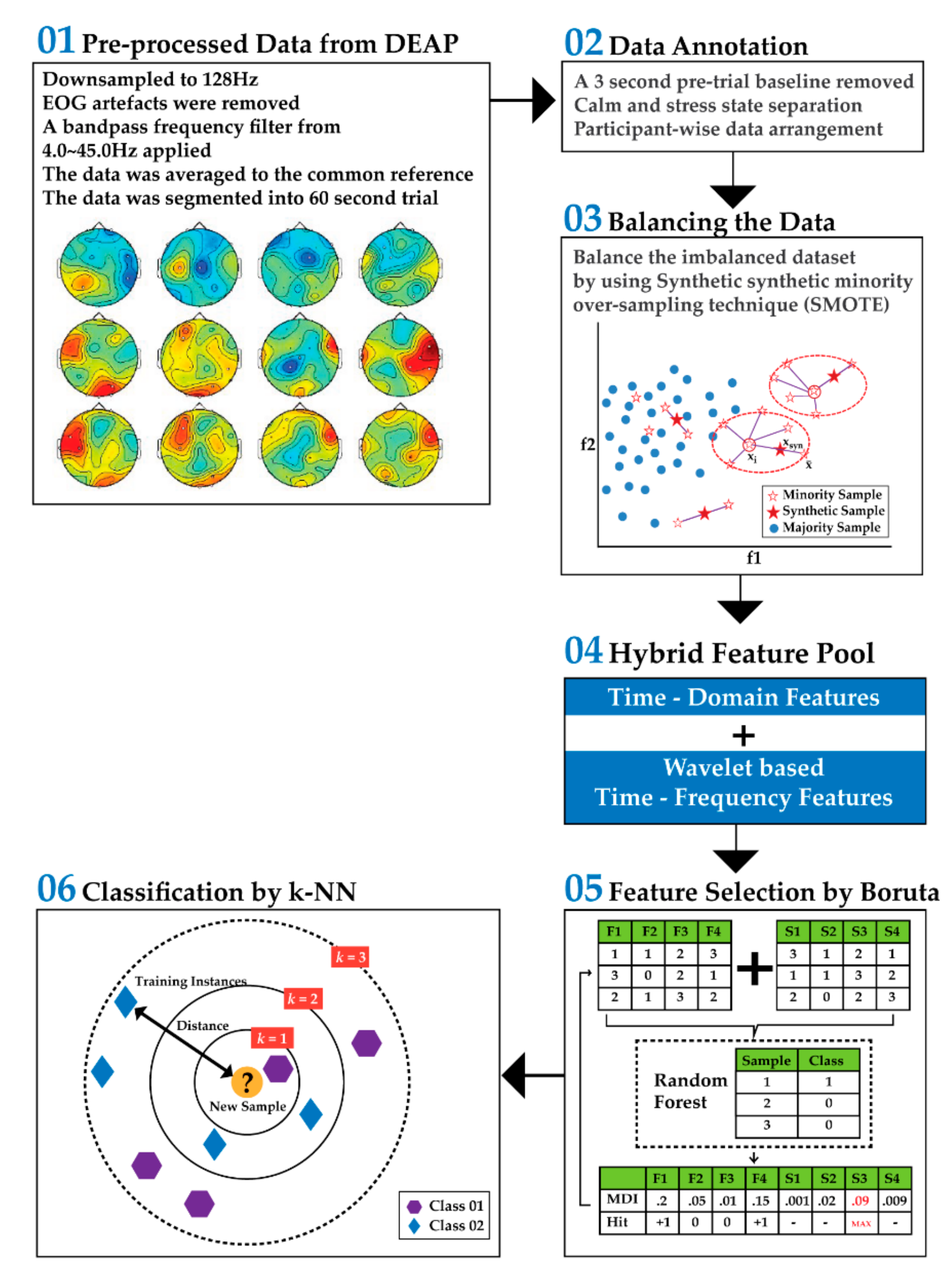

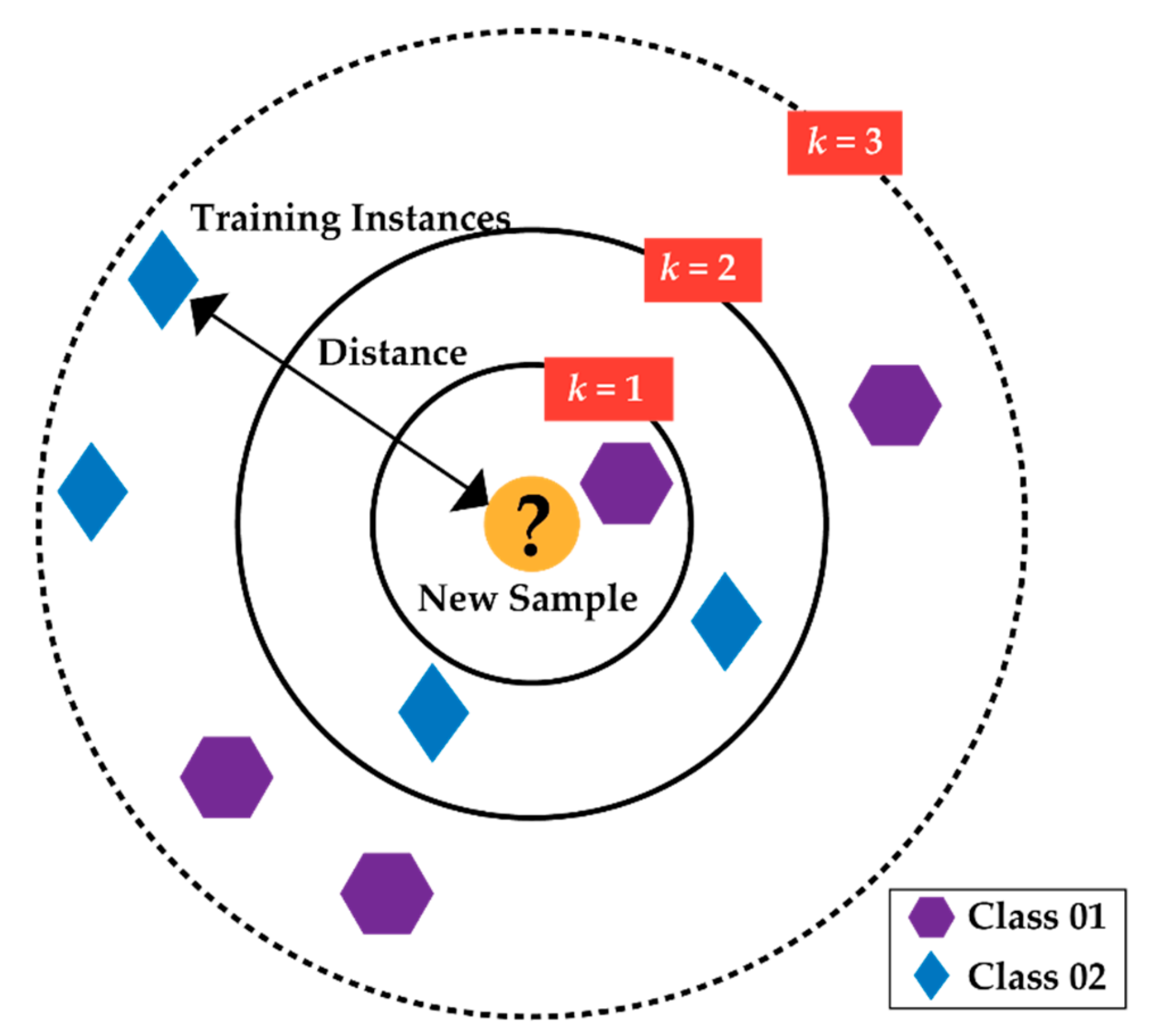
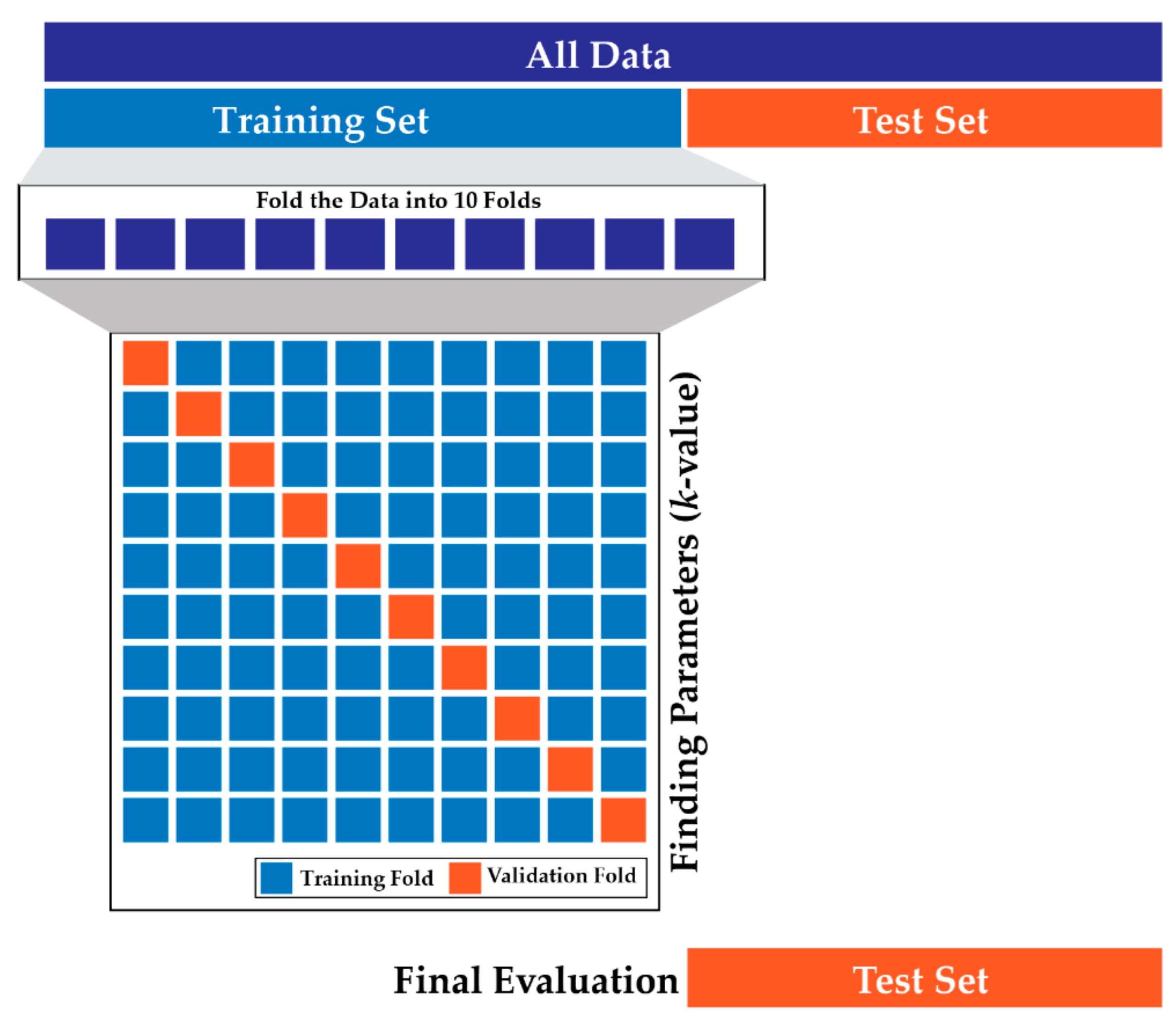
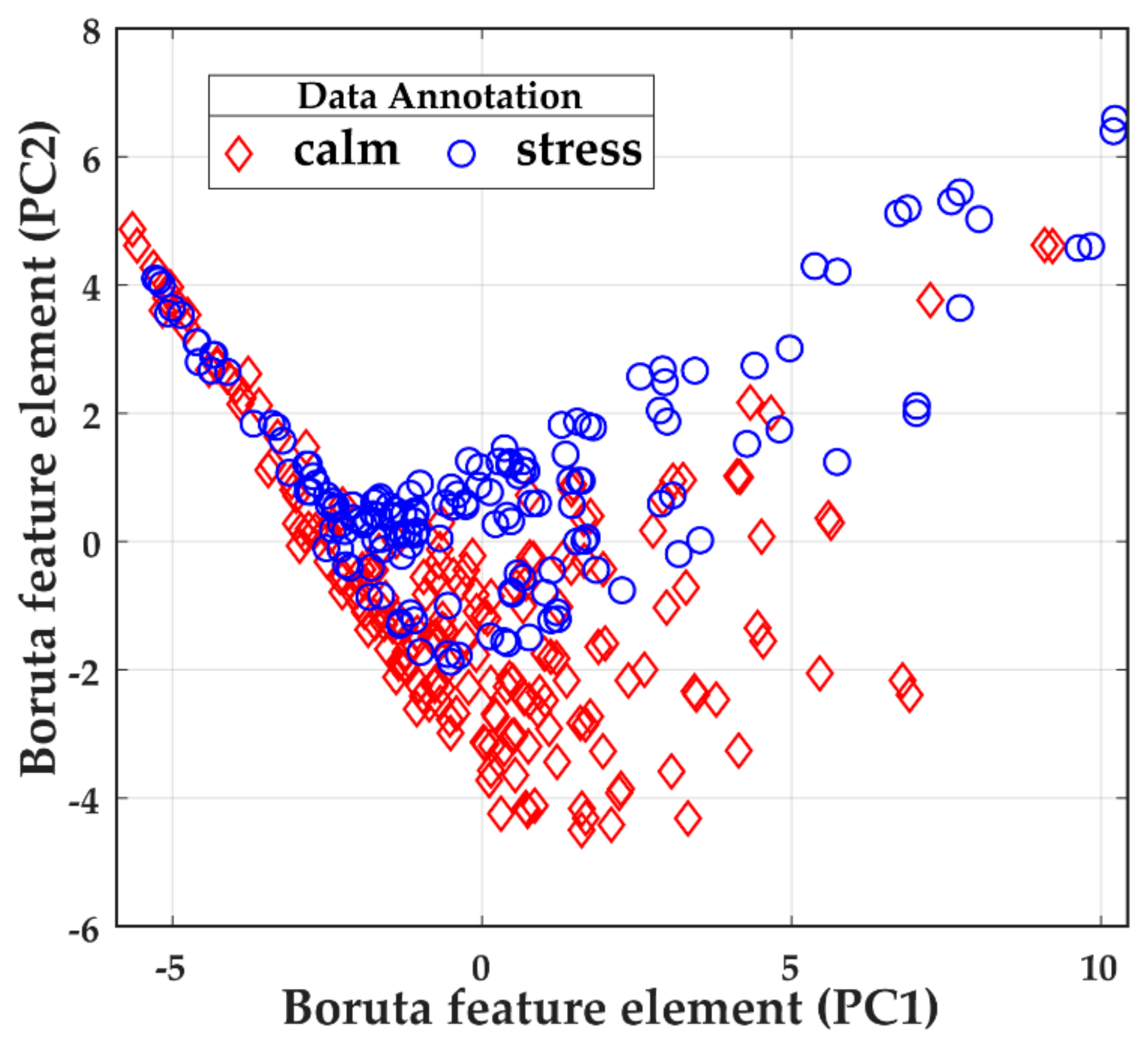
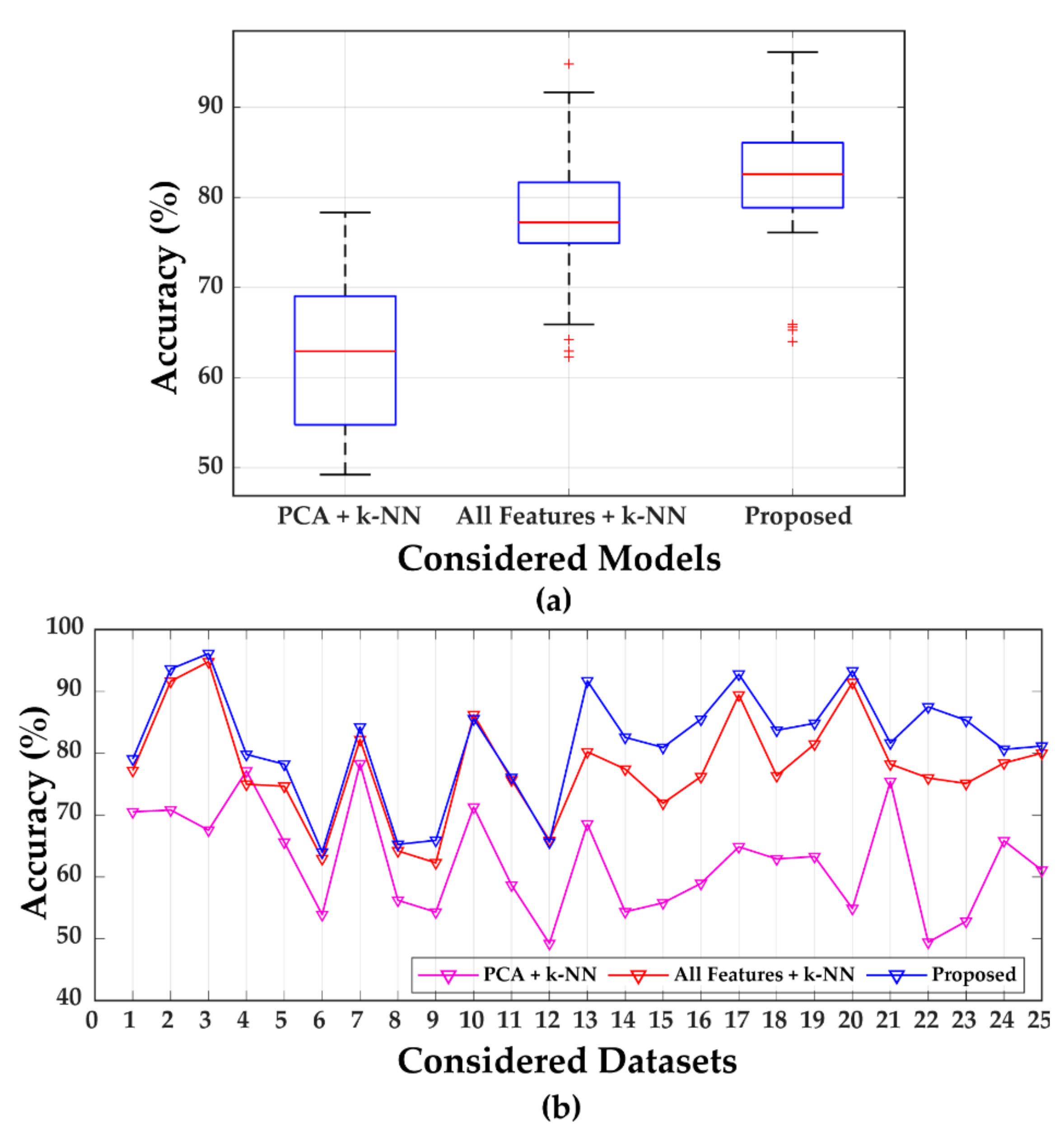
| Feature | Equation | Feature | Equation | Feature | Equation |
|---|---|---|---|---|---|
| F1 | F2 | F3 | |||
| F4 | F5 | F6 | |||
| F7 | F8 | F9 | |||
| F10 | F11 |
| Frequency Bands | DWPT Packets | Presence in the Considered DEAP EEG Filtered Signals (4–45 Hz) | Usage of DWPT Packet |
|---|---|---|---|
| Delta | 0–4 Hz | Not Present | No |
| Theta | 4–8 Hz | Present | Yes |
| Alpha | 8–12 Hz | Present | Yes |
| Beta | 14–16 Hz | Present | Yes |
| 16–32 Hz | Present | Yes | |
| Gamma | 32–36 Hz | Present | No |
| 32–40 Hz | Present | Yes | |
| 32–48 Hz | Not Present | No |
| Dataset | Participant ID | Considered Number of Channels | Experimental ID That Reflects the Distinctive State | |
|---|---|---|---|---|
| Calm | Stress | |||
| 1 | 1 | 32 EEG Channels | 9,14 | 17,32,34,35,36,37 |
| 2 | 2 | 5,7,10,22,24,36 | 29,30,32,37,38 | |
| 3 | 4 | 2,6,18 | 24,28,32 | |
| 4 | 5 | 13,29 | 23,30,37 | |
| 5 | 8 | 10,37,39 | 31,36 | |
| 6 | 10 | 15,17,20,22,26,27,28 | 21,30,35,36,37,38,39 | |
| 7 | 11 | 2,12,16,19,25,26,28,40 | 27,35,37,38,39 | |
| 8 | 12 | 16,17,28 | 25,29,32,33,35,36,37,38 | |
| 9 | 13 | 12,15,16 | 7,21,23,31,34,35,36,37,38,39 | |
| 10 | 14 | 22,27 | 10,21,23,24,29,30,32,34,35,36,38 | |
| 11 | 15 | 7,16,22,26 | 24,25,30,38 | |
| 12 | 16 | 6,12,16,21,36 | 1,15,17,24,26,27,34 | |
| 13 | 18 | 22,26,34 | 30 | |
| 14 | 19 | 15,26,27 | 29,38 | |
| 15 | 20 | 16,26,27,28,40 | 23,25,29 | |
| 16 | 21 | 3,21,26,34,35 | 20,22,24 | |
| 17 | 22 | 1,6,12,15,16,28 | 23,24,29,30,32,33,35,36,37,38,39 | |
| 18 | 24 | 33,40 | 21,23,24,30,31,38,39 | |
| 19 | 25 | 4,5,26,27,28,34 | 2,10,23,29,31,32,33,37,38,39 | |
| 20 | 26 | 30 | 34 | |
| 21 | 27 | 5,15,19,26,27,28,33,40 | 27 | |
| 22 | 28 | 15,22,24,25 | 35,38 | |
| 23 | 29 | 15,17 | 30,31,33,35 | |
| 24 | 31 | 17,22,24,27,28,29 | 23,32,34,37,38,39 | |
| 25 | 32 | 2,6,15,26,33 | 24,30,37 | |
| Dataset | Participant ID | Class-Wise Accuracy (%) | Avg. Accuracy (%) | |
|---|---|---|---|---|
| Calm | Stress | |||
| 1 | 1 | 79.45 | 78.68 | 79.07 |
| 2 | 2 | 93.59 | 93.65 | 93.62 |
| 3 | 4 | 97.14 | 95.24 | 96.13 |
| 4 | 5 | 75 | 83.33 | 79.82 |
| 5 | 8 | 77.78 | 78.95 | 78.23 |
| 6 | 10 | 62.5 | 65.48 | 64.00 |
| 7 | 11 | 85.48 | 82.97 | 84.23 |
| 8 | 12 | 59.35 | 73.14 | 65.26 |
| 9 | 13 | 62.61 | 69.22 | 65.92 |
| 10 | 14 | 82.20 | 88.96 | 85.58 |
| 11 | 15 | 79.59 | 72.22 | 76.09 |
| 12 | 16 | 62.71 | 68.52 | 65.62 |
| 13 | 18 | 95.29 | 88.13 | 91.71 |
| 14 | 19 | 76 | 92.86 | 82.58 |
| 15 | 20 | 82.73 | 79.15 | 80.94 |
| 16 | 21 | 88.51 | 82.49 | 85.5 |
| 17 | 22 | 92.13 | 93.44 | 92.79 |
| 18 | 24 | 73.46 | 93.98 | 83.72 |
| 19 | 25 | 82.22 | 87.49 | 84.85 |
| 20 | 26 | 86.67 | 100 | 93.33 |
| 21 | 27 | 84.43 | 78.92 | 81.66 |
| 22 | 28 | 88.49 | 86.53 | 87.51 |
| 23 | 29 | 85.73 | 84.92 | 85.33 |
| 24 | 31 | 82.43 | 78.75 | 80.62 |
| 25 | 32 | 83.78 | 75.86 | 81.17 |
| Dataset | Participant ID | PCA + k-NN | All Features + k-NN | Proposed |
|---|---|---|---|---|
| 1 | 1 | 70.52 | 77.22 | 79.07 |
| 2 | 2 | 70.83 | 91.65 | 93.62 |
| 3 | 4 | 67.56 | 94.81 | 96.13 |
| 4 | 5 | 77.14 | 75.0 | 79.82 |
| 5 | 8 | 65.62 | 74.67 | 78.23 |
| 6 | 10 | 53.89 | 62.95 | 64.00 |
| 7 | 11 | 78.32 | 82.22 | 84.23 |
| 8 | 12 | 56.22 | 64.21 | 65.26 |
| 9 | 13 | 54.31 | 62.28 | 65.92 |
| 10 | 14 | 71.29 | 86.23 | 85.58 |
| 11 | 15 | 58.68 | 75.71 | 76.09 |
| 12 | 16 | 49.23 | 65.91 | 65.62 |
| 13 | 18 | 68.55 | 80.24 | 91.71 |
| 14 | 19 | 54.36 | 77.44 | 82.58 |
| 15 | 20 | 55.81 | 71.92 | 80.94 |
| 16 | 21 | 58.94 | 76.22 | 85.5 |
| 17 | 22 | 64.87 | 89.44 | 92.79 |
| 18 | 24 | 62.91 | 76.36 | 83.72 |
| 19 | 25 | 63.30 | 81.49 | 84.85 |
| 20 | 26 | 54.89 | 91.45 | 93.33 |
| 21 | 27 | 75.43 | 78.25 | 81.66 |
| 22 | 28 | 49.43 | 76 | 87.51 |
| 23 | 29 | 52.82 | 75.12 | 85.33 |
| 24 | 31 | 65.85 | 78.42 | 80.62 |
| 25 | 32 | 61.09 | 80.03 | 81.17 |
| Methods | Dataset | Avg. Accuracy (%) | Decrement from the Proposed Method (%) |
|---|---|---|---|
| PCA + k-NN | Merged dataset | 65.62 | 7.76 |
| All Features + k-NN | 69.26 | 4.12 | |
| Proposed | 73.38 | - |
© 2019 by the authors. Licensee MDPI, Basel, Switzerland. This article is an open access article distributed under the terms and conditions of the Creative Commons Attribution (CC BY) license (http://creativecommons.org/licenses/by/4.0/).
Share and Cite
Hasan, M.J.; Kim, J.-M. A Hybrid Feature Pool-Based Emotional Stress State Detection Algorithm Using EEG Signals. Brain Sci. 2019, 9, 376. https://doi.org/10.3390/brainsci9120376
Hasan MJ, Kim J-M. A Hybrid Feature Pool-Based Emotional Stress State Detection Algorithm Using EEG Signals. Brain Sciences. 2019; 9(12):376. https://doi.org/10.3390/brainsci9120376
Chicago/Turabian StyleHasan, Md Junayed, and Jong-Myon Kim. 2019. "A Hybrid Feature Pool-Based Emotional Stress State Detection Algorithm Using EEG Signals" Brain Sciences 9, no. 12: 376. https://doi.org/10.3390/brainsci9120376
APA StyleHasan, M. J., & Kim, J.-M. (2019). A Hybrid Feature Pool-Based Emotional Stress State Detection Algorithm Using EEG Signals. Brain Sciences, 9(12), 376. https://doi.org/10.3390/brainsci9120376






